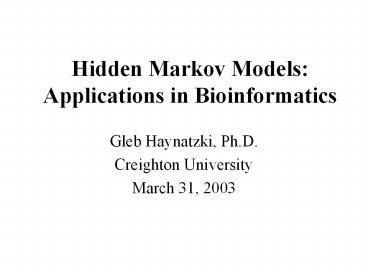Hidden Markov Models: Applications in Bioinformatics - PowerPoint PPT Presentation
Title:
Hidden Markov Models: Applications in Bioinformatics
Description:
Hidden Markov Models: Applications in Bioinformatics Gleb Haynatzki, Ph.D. Creighton University March 31, 2003 Definition A Hidden Markov Model (HMM) is a discrete ... – PowerPoint PPT presentation
Number of Views:307
Avg rating:3.0/5.0
Title: Hidden Markov Models: Applications in Bioinformatics
1
Hidden Markov Models Applications in
Bioinformatics
- Gleb Haynatzki, Ph.D.
- Creighton University
- March 31, 2003
2
Definition
- A Hidden Markov Model (HMM) is a discrete-time
finite-state Markov chain coupled with a sequence
of letters emitted when the Markov chain visits
its states. - States (Q) q1 q2 q3
... - Letters (O) O1 O2 O3
3
Definition (Contd)
- The sequence O of emitted letters is called the
observed sequence because we often know it while
not knowing the state sequence Q, which is in
this case called hidden. - The triple
- represents the full set of parameters of the
HMM, where P is the transition probability matrix
of the Markov chain, B is the emission
probability matrix, and denotes the initial
distribution vector of the Markov chain.
(P, B,
)
4
Important Calculations
- Given any observed sequence O (O1,,OT)
- and , efficiently calculate P(O )
- and , efficiently calculate the hidden
sequence Q (q1,,qT) that is most likely to
have occurred i.e. find argmaxQ P(Q O) - and assuming a fixed graph structure of the
underlying Markov chain, find the parameters - maximizing P(O
)
(P, B,
)
5
Applications of HMM
- Modeling protein families
- (1) construct multiple sequence alignments
- (2) determine the family of a query sequence
- Gene finding through semi-Hidden Markov Models
(semiHMM)
6
HMM for Sequence Alignment
Consider the following Markov chain underlying a
HMM, with three types of states ? ? match
? insert ? ? delete
7
HMM for Sequence Alignment (Cont)
- The alphabet A consists of the 20 amino acids and
a delete symbol ( ) - Delete states output only with probability 1
- Each insert match state has its own
distribution over the 20 amino acids and does not
output
8
HMM for Sequence Alignment (Cont)
- There are two extreme situations depending on the
HMM parameters - The emission probs for the match insert states
are uniform over the 20 amino acids the model
produces random sequences - Each state emits one specific amino acid with
prob 1 mi ? mi1 with prob 1 the
model produces the same sequence always
9
HMM for Sequence Alignment (Cont)
- Between the two extremes consider a family of
somewhat similar sequences - A tight family of very similar sequences
- A loose family with little similarity
- Similarity may be confined to certain areas of
the sequences if some match states emit a few
amino acids, while other match states emit all
amino acids uniformly/randomly
10
HMM for Sequence Alignments Procedure
- (A) Start with training, or estimating, the
parameters of the model using a set of
training sequences from the protein family - (B) Next, compute the path of states most likely
to have produced each sequence - (C) Amino acids are aligned if both are produced
by the same match state in their paths - (D) Finally, indels are inserted appropriately
for insertions and deletions
11
Important Calculations
- Given any observed sequence O (O1,,OT)
- and , efficiently calculate P(O )
- and , efficiently calculate the hidden
sequence Q (q1,,qT) that is most likely to
have occurred i.e. find argmaxQ P(Q O) - and assuming a fixed graph structure of the
underlying Markov chain, find the parameters - maximizing P(O
)
(P, B,
)
12
Example
- Consider CAEFDDH, CDAEFPDDH
- Suppose the model has length 10, and the most
likely paths for the two sequences are - m0m1m2m3m4d5d6m7m8m9m10 and
- m0m1i1m2m3m4d5 m6m7m8m9m10
13
Example (Contd)
- The alignment induced is found by aligning
positions generated by the same match state - m0 m1 m2 m3 m4 d5 d6 m7m8m9m10
- C A E F D D H
- C D A E F P D D H
- m0 m1 i1 m2 m3m4 d5 m6m7m8m9m10
14
Example (End)
- This leads to the following alignment
- C AEFDDH
- CDAEFPDDH
15
HMM Strengths Weaknesses
- HMM aligns many sequences with little computing
power - HMM allows the sequences themselves to guide the
alignment - Alignments by HMM are sometimes ambiguous and
some regions are left unaligned in the end - HMM weaknesses come from their strengths the
Markov property and stationarity
16
- Thank you.

